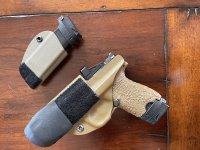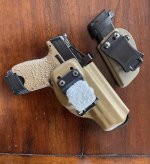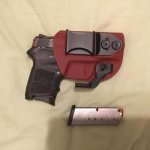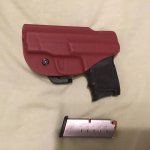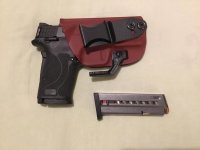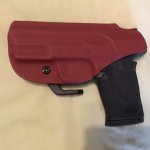I carry a full sized M&P AIWB in a JM Custom Kydex holster—older one, without the claw. I have an extended barrel so Tony made the holster longer for that, and I like the full sweat guard to give the whole holster stability.
I have the same holster for my Shield, which also has an extended barrel and therefore an extended holster. The extra long holster keeps the gun from tipping outward and printing, and I find it is actually more comfortable than a shorter holster.
Another piece of advice, depending on your body shape, I like to put a piece of loop Velcro on the back of the holster for increased comfort. Usually I will add a small closed cell foam wedge to the bottom for additional comfort and stability.
The heavy duty belt clip allows me to take the holster off as necessary easily from a good Wilderness Tactical infinitely adjustable nylon belt. Sometimes as little as a 1/4” adjustment can make a difference during the day for comfort. I also add loop Velcro to the front of the belt clip where the hook Velcro tail of my belt goes. Additional security.
Carry around the house with the pistol unloaded and uncovered. Get used to it. Draw, dry fire and reholster a lot (100+j unloaded. Reholster slowly and carefully looking the gun right down into the cleared holster. Tip your hips forward as you do to keep the muzzle pointed away from you.
Once the gun is safely in the proper Kydex holster, it will not fire. It will not fire if you draw with your finger off the trigger. Just as with 4 o’clock, but with much better holster visibility, reholster carefully with your finger off the trigger, pathn to holster clear and muzzle pointed out. Very safe.
Use the same dry practice routine for concealed carry until you are comfortable. Slow, perfect draw practice will deliver fast perfect draw strokes eventually.
Then go somewhere you can do live fire from the holster. Go slow. Get comfortable. Some day(s) after that start carrying for real, loaded, but keep up dry practice at home.

